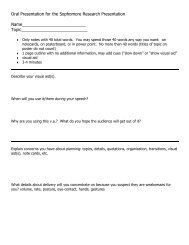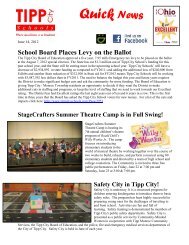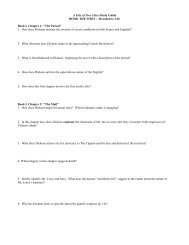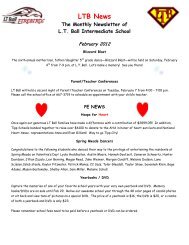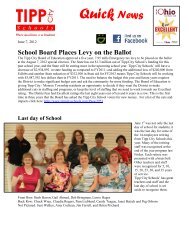Writing Workshop: Varying Sentence Structures Topic - Tipp City ...
Writing Workshop: Varying Sentence Structures Topic - Tipp City ...
Writing Workshop: Varying Sentence Structures Topic - Tipp City ...
You also want an ePaper? Increase the reach of your titles
YUMPU automatically turns print PDFs into web optimized ePapers that Google loves.
<strong>Writing</strong> <strong>Workshop</strong>: <strong>Varying</strong> <strong>Sentence</strong> <strong>Structures</strong><strong>Topic</strong>: When we write, we often have the tendency to use simple sentences (subject + verb) because it is the quickestand easiest way to get our thoughts down on paper. However, it is often NOT the easiest to read. Below, fill out thechart for each sentence in your paper. When you see yourself starting with the same or similar sentence starts or usingsimilar sentence lengths, you will be alerted to combine/rewrite that area of your paper.Sent.Write the first 3-5 words of each sentence here.# of words in Rewrite/Combine#sentence?1 The chunnel is a 8 Combine w/ sent 2
Sent.#Write the first 3-5 words of each sentence here.# of words insentenceRewrite/Combine?
Eliminating Wordiness Suggestions1. Combine <strong>Sentence</strong>s to eliminate needless repetition.Repetitive: Bob went to the store. The store was located on 8th Street.Combined: Bob went to the store on 8th Street.2. Cut redundancy & repetition.Redundancy: Juan enjoys his job as a mail carrier.Concise: Juan enjoys working as a mail carrier.3. Cut long-winded phrases.Long-winded phrase: At this point in time,...Shorter version: Now,...4. Cut expletive constructions.Expletive construction: There are many people who like Tom.Without expletive: Many people like Tom.5. Reduce clauses to phrases.Clause: Because Jane was feeling sleepy, she went to bed early.Phrase: Feeling sleepy, Jane went to bed early.6. Replace passive verb forms of "to have" and "to be" (is, was, were, are) with active verbsthat show action.Passive: She had the wheel in her hands.Active: She gripped the wheel in her hands.~~~~~~~~~~~~~~~~~~~~~~~~~~~~~~~~~~~~~~~~~~~~~~~~~~~~~~~~~~~~~~~~~~~~~~~~~~~~~SENTENCE COMBINING/SENTENCE VARIETYOne mark of good writing is sentence variety. Practice the following techniques and try to use them as yourevise.1. One way to vary sentences is by rearranging the words.Descriptive words, for example, can be placed in front of nouns. Instead of writing three sentences--Theproblem required a solution. The problem was difficult. The solution had to be immediate.--you couldwrite one: The difficult problem required an immediate solution.2. Another approach is to move adverbs or prepositional phrases to the front of the sentence.The adverb at the end of this sentence--He called me yesterday.--could be moved to the front: Yesterday,he called me. The prepositional phrase at the end of this sentence--He called me at noon.--could be movedto the front: At noon, he called me.3. An easy, but sometimes overused, way to combine sentences is with a comma and conjunction: and,but, or, for, so, yet, nor. This will give you a compound sentence.Instead of two sentences--I could not see any pedestrians. I drove through the intersection. --you couldwrite a compound sentence: I could not see any pedestrians, so I drove through the intersection.
4. Another way to link sentences is by using a semicolon either alone or with an adverbial conjunction:then, however, nevertheless, consequently, on the other hand, in addition, furthermore, therefore,for example, thus, also, etc.Using this method, the example in #3 could be written like this: I could not see any pedestrians; therefore,I drove through the intersection.5. You can also combine sentences by making a list.Instead of three sentences--The engine coughed. The engine sputtered. Then it quit altogether.--you couldwrite one: The engine coughed, sputtered, and then quit altogether.6. <strong>Sentence</strong>s can be combined by using signal words (subordinating conjunctions) to make dependentclauses that connect ideas.Common signal words include the following: although, even though, though, after, as, as soon as, while,because, since, before, if, unless, until, when, whenever, etc. To illustrate, these two sentences--He studiedfor two hours. Then he ate dinner.--could be written like this: He ate dinner after he had studied for twohours. Or it could have been written like this: After he had studied for two hours, he ate dinner.7. Another effective way to combine sentences is to omit unnecessary words, especially pronouns,linking verbs, and wordy phrases such as "is because" or "is when."For example, these two sentences--My street never has any heavy traffic. The reason that it never has anyheavy traffic is because the pavement is full of potholes.--can be written much more concisely: My streetnever has any heavy traffic because the pavement is full of potholes.Here is another example not only of omitting unneeded words but of rearranging the word order so thattwo sentences--The President doodled in her notebook. She was bored by the endless arguments.--canbecome one: Bored by the endless arguments, the President doodled in her notebook. (Note: This is anexample of a past participle modifier.)8. Changing verbs to the -ing form (present participles) can often help you combine sentenceseffectively.Two short, repetitious sentences--Jay stepped out of the sauna. Jay glowed with health.--could become onesentence: Stepping out of the sauna, Jay glowed with health. Or: Glowing with health, Jay stepped out ofthe sauna.9. The word "with" is often an effective connector.For example, these four choppy sentences--Manny looks terrible. He has bags under his eyes. His hair is amess. His clothes are rumpled.--could be one smooth one: Manny looks terrible, with bags under his eyes,messy hair, and rumpled clothes. Or: With bags under his eyes, messy hair, and rumpled clothes, Mannylooks terrible.10. Adjective clauses (also called relative clauses) are word groups which include a verb and areintroduced by one of the following signal words (relative pronouns): who, whom, whose, which,that; these clauses can be used to combine sentences.For instance, these two sentences--My friend Sal stopped by yesterday. Sal is a painter--could be writtenas one: My friend Sal, who is a painter, stopped by yesterday. An appositive, similar to an adjective clausebut without the signal word or the verb, can lead to an even more concise sentence: My friend Sal, apainter, stopped by yesterday.




